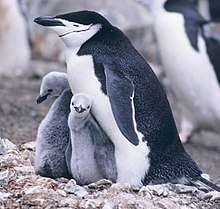Pygoscelis
| Brush-tailed penguins Temporal range: Eocene to present | |
|---|---|
 | |
| Pygoscelis antarctica | |
| Scientific classification | |
| Kingdom: | Animalia |
| Phylum: | Chordata |
| Class: | Aves |
| Order: | Sphenisciformes |
| Family: | Spheniscidae |
| Genus: | Pygoscelis Wagler, 1832 |
| Species | |
|
Pygoscelis adeliae | |
The genus Pygoscelis ("rump-legged") contains three living species of penguins collectively known as "brush-tailed penguins".[1]
Taxonomy
Mitochondrial and nuclear DNA evidence suggests the genus split from other penguins around 38 million years ago, about 2 million years after the ancestors of the genus Aptenodytes. In turn, the Adelie penguins split off from the other members of the genus around 19 million years ago.[2]
The three extant species are:
- Adélie penguin, Pygoscelis adeliae
- Chinstrap penguin, Pygoscelis antarctica
- Gentoo penguin, Pygoscelis papua
Extinct species:
- Pygoscelis grandis (Bahía Inglesa Formation, Late Miocene/Early Pliocene of Bahía Inglesa, Chile)
- Pygoscelis calderensis (Bahía Inglesa Formation, Late Miocene of Bahía Inglesa, Chile)
- Pygoscelis tyreei (Pliocene of New Zealand)
The latter two are tentatively assigned to this genus.
Species photographs
Photographs of adult penguins of the extant (living) species:
- The three extant species of the genus
 Chinstrap penguin
Chinstrap penguin
Pygoscelis antarctica Gentoo penguin
Gentoo penguin
Pygoscelis papua Adélie penguin
Adélie penguin
Pygoscelis adeliae
References
- ↑ "Pygoscelis". www.pinguins.info. 2000. Retrieved 2016-10-02.
- ↑ Baker AJ, Pereira SL, Haddrath OP, Edge KA (2006). "Multiple gene evidence for expansion of extant penguins out of Antarctica due to global cooling". Proc Biol Sci. 273 (1582): 11–17. doi:10.1098/rspb.2005.3260. PMC 1560011. PMID 16519228.
This article is issued from
Wikipedia.
The text is licensed under Creative Commons - Attribution - Sharealike.
Additional terms may apply for the media files.